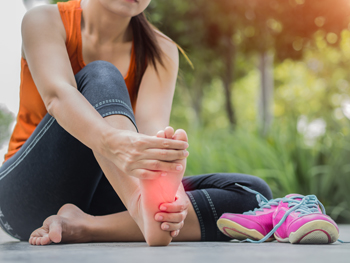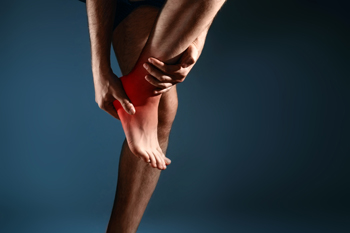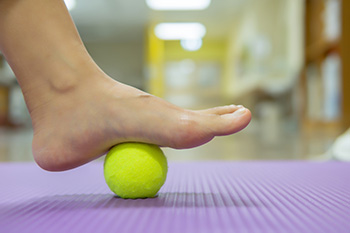Connect With Us
Blog
Items filtered by date: September 2022
Tips for Beginner Runners

All runners sustain injuries from time to time. If you are a beginning runner, it is important to start slowly and maintain a training level a bit beneath your ability. Over- training is one of the first ways runners get injured. If you become injured while running, resting is the first course of action. So, for example, if you pull a muscle, stop running and walk for a bit to see if the pain diminishes. Rest until you can resume running pain free. Most injuries suffered as beginning runners are minor and heal quickly but if your pain persists, it is suggested you see a podiatrist for a proper diagnosis and treatment, as well as additional tips on running safely.
Exercising your feet regularly with the proper foot wear is a great way to prevent injuries. If you have any concerns about your feet, contact one of our podiatrists of Tri-Town Podiatry. Our doctors will treat your foot and ankle needs.
How to Prevent Running Injuries
Many common running injuries are caused by overuse and overtraining. When the back of the kneecap starts wearing out and starts causing pain in your knee, this is commonly referred to as runner’s knee. Runner’s knee is a decrease in strength in your quadriceps and can occur if you’re not wearing properly fitted or supporting shoes. To prevent runner’s knee, focusing on hip strengthening is a good idea, as well as strengthening your quads to keep the kneecaps aligned.
What Are Some Causes of Running Injuries?
- One cause of a common running injury is called iliotibial band syndrome.
- Plantar fasciitis is also another common injury.
- Stress fractures can occur from overtraining, lack of calcium, or even your running style.
Best Ways to Prevent Running Injuries
- Wear footwear that fits properly and suits your running needs.
- Running shoes are the only protective gear that runners have to safeguard them from injury.
- Make a training schedule. Adding strengthening exercises as well as regular stretching can help keep you strong and limber and can lessen the possibility of injuries.
- Stretching keeps muscles limber; this will help you gain better flexibility.
If you have any questions please feel free to contact our offices located in Arlington, Canton, and Chelsea, MA . We offer the newest diagnostic and treatment technologies for all your foot and ankle needs.
Surgery for Bunions

A bunion is a foot deformity that manifests itself as a bony bump near the joint of the big toe. Importantly, bunions might also form at the base of the pinky toe as well, which are known as bunionettes. If you have a bunion, you may experience any number of symptoms, including swelling at the affected joint, redness, and possibly pain. If you have a severe case of bunions that does not respond to other forms of treatment, undergoing a surgical procedure to treat your bunions may possibly be an option. Such a procedure typically requires up to six months of recovery time, and it is primarily concerned with reducing pain and bringing the metatarsophalangeal joint back into alignment. The different types of relevant surgical procedures are known as an osteotomy, arthrodesis, and exostectomy, among others. If you have bunions and think you may be a candidate for bunion surgery, contact a podiatrist today.
If you are suffering from bunions, contact one of our podiatrists of Tri-Town Podiatry. Our doctors can provide the care you need to keep you pain-free and on your feet.
What Is a Bunion?
A bunion is formed of swollen tissue or an enlargement of boney growth, usually located at the base joint of the toe that connects to the foot. The swelling occurs due to the bones in the big toe shifting inward, which impacts the other toes of the foot. This causes the area around the base of the big toe to become inflamed and painful.
Why Do Bunions Form?
Genetics – Susceptibility to bunions are often hereditary
Stress on the feet – Poorly fitted and uncomfortable footwear that places stress on feet, such as heels, can worsen existing bunions
How Are Bunions Diagnosed?
Doctors often perform two tests – blood tests and x-rays – when trying to diagnose bunions, especially in the early stages of development. Blood tests help determine if the foot pain is being caused by something else, such as arthritis, while x-rays provide a clear picture of your bone structure to your doctor.
How Are Bunions Treated?
- Refrain from wearing heels or similar shoes that cause discomfort
- Select wider shoes that can provide more comfort and reduce pain
- Anti-inflammatory and pain management drugs
- Orthotics or foot inserts
- Surgery
If you have any questions, please feel free to contact our offices located in Arlington, Canton, and Chelsea, MA . We offer the newest diagnostic and treatment technologies for all your foot care needs.
Are Bunions Affecting Your Everyday Life?
How Lupus Can Affect the Feet

Lupus is an autoimmune disease that attacks tissues throughout the body, including the feet. It can attack muscles, blood vessels, tendons, and skin around the joints of the feet, and may cause joint deformity. This can be referred to as deforming arthropathy, and the most common form is known as Jaccoud’s type arthropathy. Bearing body weight on the feet with deformed joints can be a major source of pain. Lupus can cause the feet to swell, become numb, and ache due to arthritis. This can make it difficult for a person to move and sleep, which can cause other lupus symptoms to worsen. Feet can also turn blue from sensitivity to cold, which signals a vascular disorder known as Raynaud’s phenomenon. This is when the autoimmune system attacks small blood vessels, causing them to constrict when exposed to cold. Swelling and numbness can result, and pressure on the nerves of the feet can also cause pain. Sores and blisters that develop on the feet of those patients who have lupus can be slow to heal. This may be a result of the immune system suppressing drugs that keep the disease controlled. If the skin opens from these sores, it may be prone to infection. If you have lupus and are experiencing these symptoms in your feet, please see a podiatrist who can help with treatment options that might help restore pain, and free movement and functioning.
When dealing with systemic disease of the feet, it is extremely important to check the affected areas routinely so that any additional problems are caught quickly. If you have any concerns about your feet and ankles contact one of our podiatrists from Tri-Town Podiatry. Our doctors will assist you with all of your podiatric needs.
Systemic Diseases of the Feet
Systemic diseases affect the whole body, and symptoms usually are displayed in the feet. This condition can make a patient’s ability to walk unbearable. Systemic diseases include gout, diabetes mellitus, neurological disorders, and arthritis.
Gout – is caused by an excess of uric acid in the body. Common symptoms include pain, inflammation, and redness at the metatarsal/phalangeal joint of the base big toe. Gout can be treated by NSAIDs to relieve pain and inflammation, and other drugs that lower the acid levels in the body.
Diabetes mellitus – is an increase in the level of blood sugar that the body cannot counteract with its own insulin. Failure to produce enough insulin is a factor in Diabetes.
Diabetes of the Feet
Diabetic Neuropathy – may lead to damaged nerves and affect the feet through numbness and loss of sensation.
Peripheral Vascular Disease – can restrict the blood flow to the feet, and often times lead to amputation of the feet.
If you have any questions please feel free to contact our offices located in Arlington, Canton, and Chelsea, MA . We offer the newest diagnostic and treatment technologies for all your foot and ankle needs.
Stretching the Feet Before a Workout

Before an individual begins their exercise routine, they may briefly stretch their neck, arms, and legs. It is undoubtedly important to ensure that these body parts are loose and limber. However, stretching out the feet before an exercise routine is just as important. This is because foot pain, injuries, and afflictions developed from not stretching can make it difficult to continue working out the next day. If an individual properly stretches or warms up their feet before a workout, other parts of the body may benefit. For example, depending on the stretch, the calves, hamstrings, and shins might benefit from foot stretches. Before a workout, you might consider performing the tiptoe walk. This stretch can be performed by standing on your tiptoes and walking on an exercise mat for about thirty seconds or so. Some individuals who perform this pre-workout stretch might notice increased ankle stability. When stretching, it is always important to listen to your body and never push or strain your body. If you are someone who works out frequently and has always neglected stretching the feet, contact a podiatrist. They will be able to help you with more information about stretching your feet.
Exercising your feet regularly with the proper foot wear is a great way to prevent injuries and build strength. If you have any concerns about your feet, contact one of our podiatrists from Tri-Town Podiatry. Our doctors can provide the care you need to keep you pain-free and on your feet.
Exercise for Your Feet
Exercise for your feet can help you gain strength, mobility and flexibility in your feet. They say that strengthening your feet can be just as rewarding as strengthening another part of the body. Your feet are very important, and we often forget about them in our daily tasks. But it is because of our feet that are we able to get going and do what we need to. For those of us fortunate enough to not have any foot problems, it is an important gesture to take care of them to ensure good health in the long run.
Some foot health exercises can include ankle pumps, tip-toeing, toe rises, lifting off the floor doing reps and sets, and flexing the toes. It is best to speak with Our doctors to determine an appropriate regimen for your needs. Everyone’s needs and bodies are different, and the activities required to maintain strength in the feet vary from individual to individual.
Once you get into a routine of doing regular exercise, you may notice a difference in your feet and how strong they may become.
If you have any questions please feel free to contact our offices located in Arlington, Canton, and Chelsea, MA . We offer the newest diagnostic and treatment technologies for all your foot and ankle needs.

